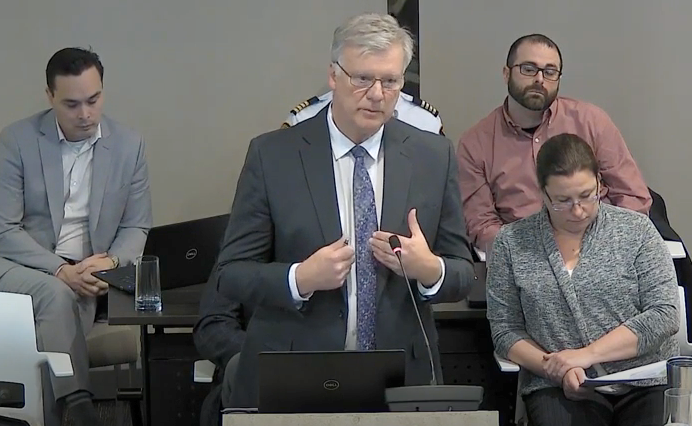A former Niagara Region Chief Administrative Officer will visit his old workplace this week to suggest a bold plan related to amalgamation, saying that $250 million can be saved over 10 years if the strategy he has put together is put in place.
Harry Schlange has 17 years of experience as the head staffer of municipal governments. In Niagara, he was CAO at the Region, as well as the Town of Fort Erie and the Town of Grimsby, from which he controversially departed late last year for reasons never specified, the second such termination from a top job since 2018.
He was also previously the top administrator with the City of Brampton.
A Niagara-on-the-Lake resident, he is registered to speak to Regional Council Thursday night, where he will pitch the idea of the Region being merged into one municipality — with one mayor, and 16 full-time councillors, who would have their own paid staff.
Currently there are 32 members of Regional Council, on top of 126 local politicians in Niagara’s 12 lower-tier municipalities.
He believes trimming from traditional services to focus on social issues such as addiction, homelessness, mental health and poverty, through the use of his estimated cost savings, is an approach that needs to be considered, he told PelhamToday sister publication the NOTL Local on Tuesday.
“If you look at the homelessness issue across the region, after the pandemic, it’s really heightened,” he said, adding that use of these savings would also help decrease taxes.
Healthcare, climate change and immigration are also areas that could financially benefit from his plan, he will tell the Region.
He said the Region and lower-tier municipalities are delivering most of their traditional services, such as economic development, planning, public works, bylaw and many others — the “same way” they did in 1970.
“It’s time for a quantum leap improvement,” he said, and to him that means current local governments in Niagara have a chance to “shape the future” by moving to a one-city, single-tier government.
He said savings can be found in reducing management payroll, changes to the procurement process, reducing external contracts costs when it comes to consultants, headhunters and legal counsel.
These are some “conservative operational improvements” that could amount to an annual cost savings of $25 million, he says in a written document he will give councillors in his presentation.
There isn’t a need for 13 CAOs, clerks and deputy clerks, and heads of various departments for each municipality, he said.
“By reducing that, and moving to a single tier, you make the organization much, much more efficient,” he believes, adding that having fewer staff leaders would be a way to recruit the “best” available.
Schlange has had a demonstrated penchant for terminating staff in some of his previous CAO roles. Taking the helm in Brampton, Schlange fired 25 senior managers in a single day, according to reporting by the Bramptonist. And former Grimsby Mayor Bob Bentley described Schlange to Niagara Now in 2021 as having "a Trump-like track record for removing anyone who dared challenge him [which is] shameful and disgusting.”
Ontario’s new Minister of Municipal Affairs and Housing recently said that instead of hiring facilitators to assess the future of six of the province’s regional governments, as was previously announced, he wants a legislative committee to handle the review.
MPP Paul Calandra said last week that he would review the move announced by his predecessor to have facilitators assess regional governments in Durham, Halton, Waterloo, York and Niagara regions and Simcoe County.
With amalgamation talks ramping up, Schlange believes now is the time for the Region and its lower- tier municipalities to start making moves.
“I think rather than wait all the time, they should develop a plan of action now,” said Schlange.
The idea of consolidating the Region goes back as far as 2000 when local governments commissioned the Berkeley Consulting Group for a study on governance review.
Needed improvements were found back then, said Schlange, but no real action was taken.
“Once amalgamation threats went away, they just went back to their normal way of doing business,” said Schlange, who added that a recent amalgamation of transit in the region was important to residents, but because there are many needed future investments to keep it viable, it won’t be the Region’s saviour.
One bone of contention that critics of amalgamation have is the impact on the identity of each town, city and township and their respective villages and hamlets.
His report said there should be a “branding” of those areas, which will continue to instill pride for residents.
He used St. Catharines as an example — saying that people from Merritton and Port Dalhousie often identify as being from those places, even though their address is technically in St. Catharines.
In Greater Fort Erie, people from Crystal Beach and Ridgeway don’t say they’re from Fort Erie.
“I think you would enhance that local identity,” said Schlange.
Niagara residents would be well served using populations and geography of Hamilton and Ottawa as comparisons, he said.
Ottawa has a population of one million — with one mayor and 24 councillors. Schlange’s calculations say this equates to one councillor per 42,000 people.
Hamilton has a mayor and 15 elected councillors, who each represent about 39,000 people within its total population of 578,000.
Niagara’s population is 480,000 — and with one mayor and 16 councillors (with their own staff), they would each serve 30,000 people.
The Region has already started a process to investigate shared services between municipalities, but Schlange called this “incrementalism,” and said it’s not the way to go.
“It’s too late for that and it’s not as efficient as single tier,” he said.
“From a behavioural perspective, I think our political leaders should do something that’s much bigger than that,” said Schlange, who also said his plan creates more accountability in local government.
With files by Dave Burket.



